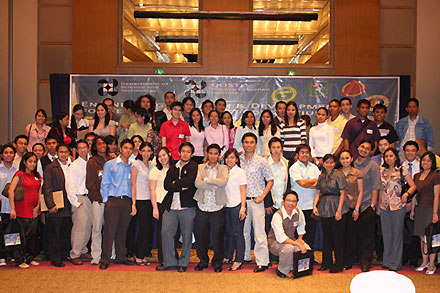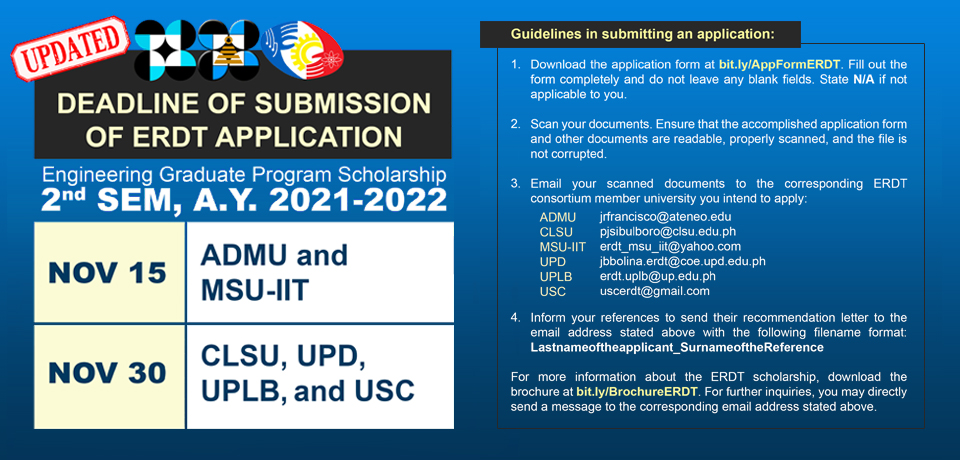1st ERDT Conference
Engineering hosts research confab*
The College heads consortium to map out the country’s engineering research and development agenda.
Two heads are better than one. Or in this case, seven.

Hopeful. The future is bright for scholars of the Engineering Research and
Development for Technology Consortium, which successfully pulled off its first
conference on September 12. The conference is the first of several that aims to
strengthen the technological competence of the country.
In an act of cooperation on a scale rarely seen, seven of the country’s most technologically inclined universities have banded together with the government and taken the first steps to try and stave off the country’s brain drain, particularly in the critical field of Engineering.
Seven leading universities from all over the country met with industry leaders and innovators in the first ever Engineering Research and Development for Technology Consortium (ERDT) Conference, held September 12 at the Renaissance Hotel in Makati City.
The seven member universities are Ateneo de Manila University, Central Luzon State University, De La Salle University, Mapua Institute of Technology, Mindanao State University-Iligan Institute of Technology, University of San Carlos and main proponent UP Diliman.
Setting the stage. According to UP College of Engineering (CoE) dean Dr. Rowena Cristina Guevara, the main purpose of this first conference, entitled Setting the Backdrop for the ERDT R&D in the Next 10 Years-Challenges and Opportunities, is pretty simple: to hear firsthand, from industry and government, what type of research the country needs. This will set the tone and direction for the research of the consortium for the next 10 years and will serve as a venue for the research that will be generated by the members. The gathering was actually a continuation of the earlier roundtable discussions begun in August 2006 when the consortium was still in its infancy.
The conference gathered the up-and-coming names in industry and government, including firms that, in some cases, are the only ones of their kind that exist in the country. Two such firms are BVN Ventures under the helm of CoE alum Francisco Sandejas and Integrated Microelectronics.
Integrated Microelectronics is the only company in the Philippines that does design and manufacturing. In his presentation, President and CEO Arthur Tan highlighted the top research priorities in the areas of manufacturing processes, energy and the environment, materials and reliability, and design.
He noted how the Philippine electronics industry has been steadily growing in the last decade, with research and development being outsourced.
“We have an edge in industry areas that are less cost-sensitive, where quality requirements and IP sensitivity are high.”
Even the medical and health professions were represented as Dr. Ramón Gustilo, Chairman and CEO of Orthopedic International, Inc. and Dr. Genandrialine Peralta of the World Health Organization spoke about the need to explore the areas of waste treatment and prosthetics.
Government officials were represented by the Department of Science and Technology (DOST)’s Undersecretary for S&T Services, Fortunato dela Peña as well as Cong. Joseph Emilio Abaya, who talked about the importance of long-term government commitment and how they are already making headway through the Technology Transfer Act.
Lofty ideals. The ERDT is a 10-year program that seeks to advance the technological competitiveness of the country by focusing on innovation-high, value-added activities and relevant technologies.
What began as an idea in August 2006 among members of the Commission on Science and Technology Education (COMSTE) has now become a full-blown endeavor, involving some of country’s best minds coupled by the financial and bureaucratic muscle of the DOST and the active participation of the private sector.
Some 150 scholars are involved in the consortium, which focuses on post-graduate education in various fields under the DOST. It consists of three components distributed among four research tracks: Energy, Environment and Infrastructure, Information and Communications Technology and Semiconductor and Electronics.
The scale of the project is virtually unprecedented, involving seven universities from all over the country. And with the equipment, infrastructure and scholarship adding up to some P3.5 billion, it is also the biggest human resource development investment ever made by the government.
The consortium hopes when the project is over, they would have produced enough MS (596) and Ph.D. (112) engineering graduates in the right research areas as to jumpstart a chain reaction that would eventually put the country on a par with other emerging economies in the region.
Brick by brick. And just how far behind are we? Recent surveys put the Philippines among the countries with the lowest ranking in terms of research output. A figure that Guevara says is dismal compared to some of our Asian neighbors.
According to Guevara, back in 2005, when UP produced one MS graduate, counterpart universities in Vietnam produced six, Thailand 25 and Singapore 200.
And while this is not necessarily the deciding factor, it is reflected in the country’s economy. In 2007, the Philippines received some $2.93 billion in foreign direct investments. By comparison, Vietnam attracted over $20 billion, much of which was encouraged by its young, highly literate workforce.
The ERDT is an attempt to keep up. Of the 154 current ERDT scholars, 33 are in the Ph.D. program while the rest are in the MS program. And with the Technology Transfer Act, which would enable government-funded inventors and innovators to profit from their ideas, already underway, things are starting to look up.
Still, there’s a lot to do. The kind of numbers the consortium is aiming for are just enough to keep up with the rest of the region, and still needs the corresponding supporting legislation to become long-term. Much of the infrastructure needed is still in the planning stage, and not all of the research proposals have been approved, but Guevara remains optimistic.
She said if a country is to grow economically, the industry should have high value-added activities ….If the government invests now, tapos na-achieve natin yung growth at saka yung scale na pinapangarap natin, mangyayari yan…Hopefully after 10 years [the duration of the project], it has become instinctive for us.”
*http://www.upd.edu.ph/~updinfo/octnovdec08/articles/confab.html


